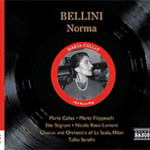
Norma (Complete Opera recorded in 1954)
 $54.00
Out of Stock
$54.00
Out of Stock6+ weeks add to cart
BELLINI
Norma (Complete Opera recorded in 1954)
Maria Callas / Mario Filippeschi / Ebe Stignani / Nicola Rossi-Lemeni / Chorus And Orchestra Of La Scala, Milan / Tullio Serafin
[ Naxos Historical Great Opera Performances / 3 CD ]
Release Date: Saturday 22 September 2007
This item is currently out of stock. It may take 6 or more weeks to obtain from when you place your order as this is a specialist product.
"The manner in which Callas colours her voice and the way she moves through the vocal register is very individual and not to every taste. If it is to yours then this Naxos realisation of the 1954 studio recording is in the best sound I have so far heard of this performance and is recommended as such."
(MusicWeb March 2005)
This recording, first published in November 1954 in the United States by Angel and in Britain by Columbia, and made at the end of April and beginning of May, was the second in the series under the aegis of La Scala, Milan, with its orchestra and chorus. Like the first, another Bellini opera, I Puritani, it was not made at the opera house but at Cinema Metropol; the season was still going on, and Tebaldi was singing Tosca.
Norma is the only bel canto opera to have been given almost continuously through the years at major theatres in Italy, and under Italian sway in the United States and Britain, since its first performance at La Scala, Milan, in 1831. In the days before recording there was a tradition of nineteenth-century Normas, including its creator Giuditta Pasta, Giuseppina Ronzi de Begnis, Maria Malibran, Giulia Grisi, Jenny Lind, Antonietta Fricci, Teresa Tietjens, Maria Vilda, Euphrosyne Parepa and Maria Peri. How their styles may have developed, in response to the then ever-changing repertory, we can only guess. By the first decades of the last century recordings of the aria Casta Diva were made by Eugenia Burzio (1872-1922) and Giannina Russ (1873-1951), both of whom undertook it at La Scala, Milan, and Ester Mazzoleni (1883-1982), who did so at the San Carlo, Naples. Their singing is more an impression than an actual account of the notes, not perhaps because they could not have sung it more accurately but because they were trying to inform music whose style was by then old-fashioned with one better suiting their own time. Their tone is often overly anguished with excessive recourse to vibrato at odds with the basis of bel canto, a suave, shapely and limpid legato, as we read in singing manuals like Manuel Garcia's L'art du chant (1847). By the second quarter of the twentieth century, when not only singers but their teachers too were reared on verismo, Normas such as Bianca Scacciati (1894-1948), Gina Cigna (1900-2001) and Maria Caniglia (1905-1979) all had big vibratory voices and used a vehement declamatory style better fitting Ponchielli's La Gioconda composed 45 years later. Their principal concern was conveying the drama and they were careless executing florid music, aspirating it and crashing vocal gears. The German Lilli Lehmann (1848-1929) and the American Rosa Ponselle (1897-1981) sang Norma more accurately (at least as recorded) and enjoyed successes with it, but did so only outside Italy and were not part of the tradition.

![La Sonnambula (Complete opera recorded in 1957) [with arias by Cherubini & Spontini] cover](https://images.marbecks.co.nz/_thumbnails/10150/10150844.jpg)

